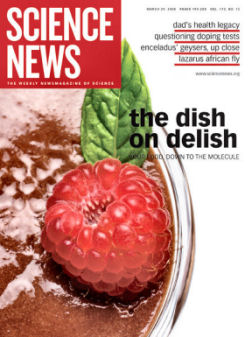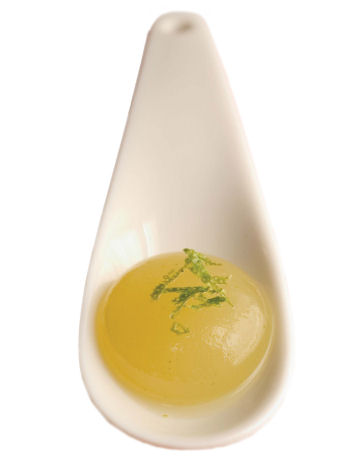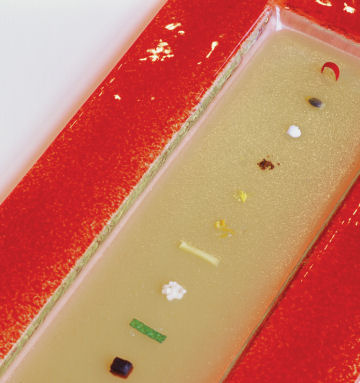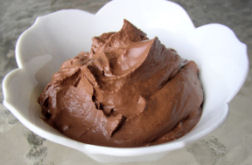- More than 2 years ago
At minibar, a six-seat restaurant within the Café Atlántico in Washington, D.C., many menu items sound familiar: Philly cheese steak, conch fritters, corn on the cob, and mojitos. But the mojito doesn’t come in a glass. It is served as a bite-sized sphere on a spoon. Calcium chloride is mixed with the traditional rum, lime, mint, and sugar. A dollop of this concoction is dropped into a bath of water and sodium alginate, a gum extracted from algae—which encloses the orb of flavor in a membrane. After a minute, it is rinsed with water to stop the gelling, transferred to a canister, then charged with carbon dioxide. A few hours later, the sphere is slightly carbonated, built to flood the taste buds in a fizzing burst of flavor.




Today, it would not be unusual to find alginate, liquid nitrogen, or lecithin in the larders of top-ranked chefs, like José Andrés of Café Atlántico, Ferran Adrià from elBulli in Roses, Spain, or Heston Blumenthal of the Fat Duck in Bray, England.
Cooks are drawing inspiration from the lab, delighting in techniques that once were the province of industry. At the same time, researchers are zealously scrutinizing food. By zeroing in on its creation in the kitchen—and destruction in the body—scientists are joining chefs in cracking the code of delicious.
Some chefs react to this new cuisine by declaring it “not real cooking.” But minibar sous chef Michael Turner disagrees. “Everything is new at first,” says Turner. “I’m sure when the first person sautéed something people were like, ‘What the hell are you doing, you must be a witch.'”
The traditional relationship between science and food might be described as an assault, yielding Spam, plastic-wrapped cheese products, and TV dinners. “Food science,” driven by the needs of industry, has been geared toward the mass production of “foodstuffs.”
Now the methods of science—controlling for variables and keeping records so that results are replicable—are spilling into the restaurant kitchen. Recipes and their accompanying lore are being rigorously dissected and described in the lab. Researchers at the forefronts of their disciplines are using principles of soft condensed matter physics, biochemistry, and molecular biology to understand bread, cheese fondue, and the mystery of milky sambuca.
“Twenty years ago there was no science of the soufflé, béarnaise, chocolate mousse, or custard,” says chemist and chef Hervé This (pronounced Tiss), of the French National Institute for Agricultural Research in Paris.
From Spam to savory
Today there is that science, as fans of Iron Chef America or Top Chef can attest, and thanks in large part to This, one of the founding fathers of the field known as molecular gastronomy. He notes, however, that the science of food is not actually new, citing observations on the density of meat that date to the 2nd century B.C.
By the late 1700s, chemist Antoine Lavoisier, when he wasn’t articulating the law of conservation of mass, carried out elaborate experiments on the preparation of meat stock. At about the same time, physicist Benjamin Thompson (later Count Rumford) had made many forays into the kitchen, inventing a double boiler and percolating coffeepot.
But Rumford and Lavoisier’s ilk were exceptions. Early efforts to preserve food by canning, prompted by a need to nourish troops on the battlefield, set the tone for science’s contribution to cooking for the modern era.
“Restaurants and the tradition of preparing elaborate recipes were mostly ignored,” says César Vega of the food research company Mars Botanical (an offshoot of Mars Inc) in Gaithersburg, Md. “The focus was on preserving food for long periods of time. And by the way, let’s do it so it tastes the same, batch after batch after batch.”
The relationship between scientists and chefs, or lack thereof, troubled the late physicist Nicholas Kurti. At a presentation for the Royal Society of London in 1969 he lamented, “I think it is a sad reflection on our civilization that while we can and do measure the temperature in the atmosphere of Venus, we do not know what goes on inside our soufflés.”
Kurti’s now famous lecture, titled “The Physicist in the Kitchen,” was a turning point, says Vega, author, with Job Ubbink, of a forthcoming review on molecular gastronomy in Trends in Food Science & Technology. “It was very impactful on the scientific community.” The lecture was peppered with demonstrations by Kurti and his daughter Camilla. They used a vacuum to remove water vapor from meringue and presented a pork loin tenderized with pineapple juice, which contains the protein-splitting enzyme bromelin.
Another milestone, says Vega, was the publication in 1984 of Harold McGee’s On Food and Cooking: The Science and Lore of the Kitchen, which explained physics and chemistry for the home cook.
Kurti and This became partners, giving molecular gastronomy its name and organizing the first international molecular gastronomy conference in Erice, Italy, in 1992. But they both had long been investigating the relationship between scientific advancements and cooking techniques.
Aiming to clean the culinary books for chefs to come, This zeroed in on “culinary proverbs,” tips included at the end of many recipes. Many of these helpful hints have persisted for centuries without being tested, This noted, such as advice to cut the heads off suckling pigs immediately after taking them out of the oven to keep their skin crispy, or the assertion that mayonnaise will fail if it is made by a woman who is menstruating. He began collecting and testing these old wives’ tales, and today he has more than 25,000 in a database, about 100 of which have been explored in his labs. (Suckling pigs: True—cutting off the head allows vapor to escape that would otherwise permeate and soften the skin. Mayonnaise: False—duh.)
Fighting equilibrium
Hervé This also brought science to the kitchen by developing formulas for representing changes in the physical states and arrangement of food. Using G, O, W, and S for gas, oil, water, and solid, transforming cream into whipped cream would, in its simplest form, appear as:
O/W + G –> (G + O)/W
Dubbed complex disperse systems (CDS) formalism by This, the approach appears cumbersome, but zooming out to the abstract reveals dishes that hadn’t been imagined. A method for preparing an eggless chocolate mousse, or “Chocolate Chantilly” as This calls it, arose out of the above whipped cream equation (see recipe, below). And the equation holds when chocolate is replaced by foie gras or cheese, This notes in a 2007 paper in the International Journal of Pharmaceutics.
To some extent, the development of this formalism “bridged the divide” between gastronomy and colloid science, says Vega. Colloids are wannabe solutions: they look uniform and smooth but are actually particles of one thing suspended in another—butter, cream, and paint are colloids. Colloid science is one aspect of soft condensed matter physics, a field that gets at the nitty-gritty of materials that can be pushed, pulled, warmed, cooled, or shocked into new shapes.
“Most foods are out of equilibrium—their structures are not what physics would like them to be,” says Raffaele Mezzenga of the University of Fribourg in Switzerland. As such, foods will want to devolve toward equilibrium—a state that’s usually contrary to the desires of the cook. Scientists, for example, are still figuring out how to delay chocolate’s tendency to “bloom” (when old chocolate turns white), which happens when cocoa butter molecules shift into a more comfortable, stable arrangement.
This path to equilibrium is dictated by the various interactions between molecules and the strength of those reactions at different scales and under different conditions—such as of pH or temperature. When the amount of energy needed to activate a chemical reaction is low, food’s progress toward equilibrium is faster, says Mezzenga, lead author on a review in a 2005 Nature Materials on understanding food in terms of soft materials.
Large additions of salt, for example, can lower activation energy. The charged sodium and chloride ions act to cancel out the electrostatic repulsion of the surrounding molecules, making them more likely to bump into each other, aggregate, and precipitate out.
But creating food is usually an attempt to quench these interactions. Foods are ephemeral arrangements of ingredients and molecules, briefly pushed into shape by heat or whisks, chemistry and physics. Creating a smooth fondue, for example, means keeping molecules apart that would rather clump together—a feat made possible by heightening the repulsion of the molecules in solution, says Mezzenga.
In a cheese fondue this job falls to the wine. Caseins, the “curd” proteins of dairy, are normally bonded together into units known as micelles. Looking a bit like a head of dandelion seeds, micelles make up between 6 and 12 percent of milk and are glued together with calcium phosphate. These micelles fall apart at a pH of 4.6, leaving the caseins to clump. But adjusting the pH with a fairly acidic wine adds more hydrogen ions in the mix; the ions surround the casein molecules, charging them up so they repel each other. If the wine isn’t acidic enough, a bit of lemon juice will do the same thing, says Mezzenga. “The Swiss fondue purist would maybe be upset, but it works, and can save your fondue.”
Stabilizing mixtures is often all about getting oil and water to live amicably together rather than demanding to be alone. Surfactants and emulsifiers are such peacemakers. They are often tadpole-shaped molecules with oil-loving (or fat-loving) tails and water-loving heads. The oil-loving tails embed themselves in a droplet of oil, leaving the water-loving heads in the water, thereby preventing like from clumping to like. Egg yolk proteins (such as lecithin) are the emulsifiers that keep mayonnaise smooth; gelling agents, such as the plant starch pectin, other starches, and citric acid are all emulsifiers.
Ouzo effect
Solutions that remain stable without emulsifiers have presented scientists with a puzzle. Anise-flavored beverages such as pastis, sambuca, and ouzo are three-ingredient solutions: water (about 55 percent), alcohol (about 45 percent), and flavored oil (about 0.1 percent). These drinks appear clear in the bottle—the proportion of alcohol, water, and oil is such that the oil is soluble in the mixture and it looks clear. But when they are served as cocktails, water is added and the drinks spontaneously turn a milky white, a phenomenon known as the “ouzo effect.” The added water tips the ratios, and the oil is no longer soluble-droplets form in the solution, scattering the light. This milky state is quite stable, lasting for months.
Scientists have studied this effect and the process is now used for creating nanocapsules and other tiny particles. But the mystery of the milky drink is not a closed case.
It isn’t clear why the milky state remains stable. Perhaps the molecules are close enough to equilibrium that they’re content to sit still. “We really don’t have a model for that kind of interface,” says Erik van der Linden of Wageningen University in the Netherlands. Normally, the recipe would call for an emulsifier to achieve such stability (if the bartender added egg yolk to your drink there would be no mystery).
Even a new approach to the problem, published by van der Linden, This, and Elke Scholten in the March 4 issue of Langmuir, offers no clear solution. The team tested an existing model of the behavior of the beverage’s molecules and found that the experimental results completely contradicted the theoretical predictions.
Phenomena like the “ouzo effect” are part of the behavior of food and drink on the shelf, or in the oven or bottle. But when Kurti and This defined molecular gastronomy in 1988, they articulated an additional area of food science research that had been largely ignored: the experience of eating.
A moment on the lips
The industry tendency to measure properties of food outside the mouth and correlate it with what people perceive is all wrong, says George van Aken of Top Institute Food and Nutrition in the Netherlands. Now scientists are looking inward—not just at taste receptors but at the entire “breakdown path” that food travels when it’s consumed. “People have been worried about how we build it but not how we destroy it,” says Vega.
Researchers are examining how color and sound affect taste, and 3-D models have been proposed to illustrate how food is deformed by the mouth. Other researchers are looking at the digestive end of things.
“What is important is in your mouth,” says van Aken, who reviews how soft foods behave under “oral conditions” in a 2007 paper in Current Opinion in Colloid & Interface Science. He points out that with soft foods, teeth play a minor role. More important are structural changes that result from heating or cooling to body temperature, the action of saliva (an adult secretes 0.5 to 1.5 liters per day), and the shearing between the palate and the tongue. “There’s no tongue like the human tongue,” van Aken says.
His description of what goes on in the mouth brings to mind Han Solo’s experience in the Death Star’s garbage compactor. A piece of cheese enters the abyss as a tidy slice, but it is quickly “masticated down to small particles.” As fats lubricate the tongue’s surface, saliva—which has a gas, liquid, and gel phase—clumps bits into a mass or bolus. Masticating continues and flavor particles are released, which catch in the various rivulets of the tongue. The human tongue is actually quite soft, notes van Aken, unlike a cat tongue, which “you could grate cheese with.”
Driven to enhance this experience in the mouth, and the few moments of presentation on the plate, some chefs, such as the team at José Andrés’ Café Atlántico and minibar, have become culinary alchemists. They use science as a tool to make something crunchy, spreadable, or spoonable and to deliver flavors in a particular order. The food surprises and delights. Head chef Katsuya Fukushima, likens the science of food to modern art, which can be enjoyed even by fans of old masters.
“Food can be such a beautiful thing—we try to make it fun,” says Fukushima, who doesn’t like the term molecular gastronomy. He agrees that science is necessary for developing concepts. “But when it comes down to it, we are just cooks.”
Chocolate Chantilly
Air in a chocolate-water emulsion
Ingredients:
200 ml (about 3/4 plus 1/8 cup) water
225-250 g (about 8 oz) bittersweet chocolate, coarsely chopped
Put water and chocolate in a saucepan. Heat, stirring until chocolate is completely melted. Put ice in large bowl. Pour chocolate-water mix into a smaller bowl and place over ice. Whisk madly to introduce air bubbles. Stop at the consistency of mousse.
(Recipe from H. This, French National Inst. for Agricultural Research)
–







